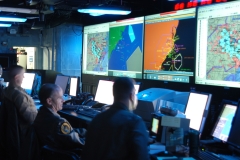The EO Law project aims at demonstrating the benefits of using EO based information together with state of the art ICT data analytics and non-EO data fusion in support of Law Enforcement in various domains, from environment to terrorism, and counter proliferation.
For this purpose the consortium that will develop the EO Law has engaged relevant users and stakeholders that work in the domains covered in the project, providing context and related requirements to support the definition of service specifications, in order to develop capabilities that can really tackle operational problems of the various areas in support of law enforcing.
Planetek is involved in the EO Law in charge of the Terrorism and organized crime component, where the following services are developed: Training camp characterization; Anomaly detection; Activity monitoring.
In this project the consortium aims at demonstrating the benefits of using EO based information together with state of the art ICT data analytics and non-EO data fusion through the implementation of selected services in a virtual platform in the Law Enforcement domain.
The EO Law project consortium: GMVIS SKYSOFT S.A. (PT) prime contractor, CLS COLLECTE LOCALISATION SATELLITES (FR), E-GEOS (IT), IABG MBH (DE), Planetek Hellas (GR).
EO Law users: Interpol, Europol, Cloudbreak, and a range of ministry of interior / Policing / border security tasks, foreign & military intelligence from EU/NATO areas.
domains and services
Environmental Crimes - Illegal Logging. In the last few years, illegal logging has emerged as a serious worldwide concern in the forest sector. By its nature of being illegal it is also clandestine, making it difficult to estimate with precision how much wood is logged illegally, where exactly, and by whom. What is known though, is that illegal logging remains a very big problem despite existing efforts to fight it.
In this context, the consortium will develop services that can help on the investigation and mitigation of the consequences that result from the illegal logging activities, namely:
- Detection of routes for movement of timber
- Detection of forest change
- Detection of logging support infrastructure
Crimes against humanity – As crimes against humanity are still occurring on a regular basis, there are in contrary often not “visible” to the wider public. This is based mainly on the fact that hostile actions are taken place most of the times in remote and less-accessible areas, where accessibility is limited either due to e.g. armed conflicts or wars, or due to governmental restrictions. As the amount of in-sight information rapidly increased during the last years due to e.g. social media, the confidence level of the information overload was decreasing making it harder to distinguish between “wrong” or “right”.
EO-data and EO-derived information can be seen as an independent information source suitable to verify on-sight information and to gain a more sound evidence of actions taken place. The services that will be provided are:
- Multi-criteria mass grave site suitability model
- Fire detection in settlements
- Settlement development & change detection
Terrorism and organized crime – Societies today constantly face terrorist and organize crime actions, which require new methods for modelling and analysis, inherited from various sectors and technological domains. Law enforcement organizations, analysts and field operators fighting terrorism and organized crime need front-line integrated technologies to support their cooperative work.
The goal of the services will be spatially depict the activities of different terrorist organizations by means of generalized locations, anomaly characterization/interpretation and also activity analysis. Preparing helpful and applicable/realistic services requires the fusion of multi-source data combining unstructured (descriptive and informational data sources) and structured geospatial data (vector and satellite data) as well as information from open source and public databases like social media networks, crowdsource information etc.
The services that will be provided are:
- Comprehensive and contextual imagery intelligence analysis combing EO data and media sources
- Hotspot detection layer with potential training camps
- Hotspot detection layer with potential abnormal activities related to terrorism and organized crime
All the services will be deployed through a virtual web platform that will be used for service ordering, processing and delivery. This platform will be composed by a set of software components integrated together and implemented on a data-rich cloud infrastructure so that the EO data can be accessed online and without the need to transfer it from external sources.






